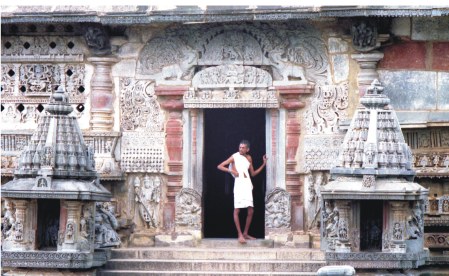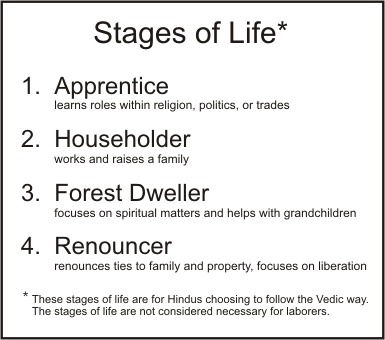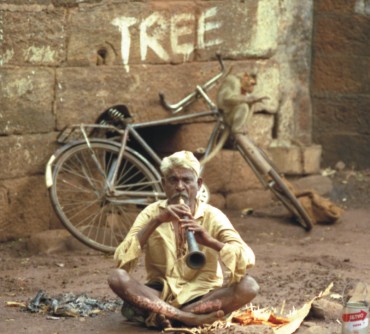
A still functioning temple in South India (Belur) with the Brahman priest.
Friezes represent Hindu deities and guardian beasts, sculpted about 1000 years ago.
Home - Intro - Table of Contents - Buddhism - China - Islam - Judaism
Christianity - Aaron's Travels/Studies - Bibliography - Index - Bookstore
My section on Hinduism starts from the earliest Sanskrit scriptures (Vedas) in the Rig Veda to the current religious practices. To the majority of Hindus today, God is conceived of as Vishnu (or a form of Vishnu). A sizable portion of Hindus worship the creative (often ascetic and refining) qualities of God as Shiva. Hindus recognize, respect and often worship the feminine qualities and/or reality of God. Shakti worship focuses on God's manifested "power" embodied as the female. For example, Durga is seen slaying demons and protecting worshippers. The two quotes, chart and photos are from pages 50-51, 54-56, and 59 of Love Your Neighbors? Discover the real world religions.
_______________________________

Ultimately, Hinduism recognizes an all-encompassing, even
transcendent power proceeding all form, whether a creator or any aspect of
creation. This essence is timeless, formless, beyond all attributes, and
referred to as Brahman.[3] An aspect of this formless Brahman is the
Atman, or real “Self.” The changeless essence of existence indwells the
human spirit. Originally in the Rig Veda, Atman meant the breath or whole
self. Spiritual progress or final liberation and enlightenment is attained when
realizing Brahman is intimately connected to the Atman — Tat tvam asi,
“That art thou.” All life forms will re-incarnate until realizing the ultimate
existence, that thou art Brahman.
As stated, intellectual and
philosophical discourse expanded from Vedic hymns. One of the ten main
Upanishads elaborated on the Atman as the supreme Self.
As birds resort to a tree for a resting place, even so, O friend, it is to the supreme Self (Atman) that everything here resorts: Earth and the elements of earth, water, and the elements of water, heat and the elements of heat, wind and the elements of wind, space and the elements of space, sight and what can be seen, hearing and what can be heard, smell and what can be smelled, taste and what can be tasted, the skin and what can be touched, speech and what can be spoken, the hands and what can be taken, the organ of generation and what can be enjoyed, the anus and what can be excreted, the feet and what can be walked, mind (manas) and what can be perceived, intellect (buddhi) and what can be conceived, egoism and what can be connected with ‘me,’ thought and what can be thought, brilliance and what can be illumined, life-breath and what can be supported. Truly, this seer, toucher, hearer, smeller, taster, thinker, conceiver, doer, the conscious self, the person — his resort is in the supreme imperishable Self, the Atman.” (Prasna Upanishad 4.7-9)[4]
[footnote 3] This Brahman is a neuter noun and should not be mistaken with
the Brahman priest or with Brahma, considered to be the creator aspect of God.
[footnote 4] Sarvepalli Radhakrishnan and Charles A. Moore (eds.), A
Sourcebook in Indian Philosophy, Princeton University Press: Princeton NJ,
1957, pp. 50-51.
_______________________________

Another system stemming from the Vedas relies on the four primary
stages of life, which stabilize the spiritual well being within a Hindu society
(see the chart). The spiritual development of individuals within society was
very important and could assist the maintenance of families and work ethics. For
most Hindus, every stage of life had its proper time. Members from three of the
four castes would engage in a type of “apprenticeship.” For instance a boy from
the priest caste would usually begin his trade by moving in with a teacher of
the Vedas at age eight, a member from the princely caste at eleven, and those
from the trade caste at fourteen. Periods of study might vary before proceeding
to the “householder” stage where each individual worked within the caste and
raised a family. Ideally, the householder stage extended twenty-five years and
was necessary to support the next stages where the son’s family would support
the father and mother when they retired from all worldly concerns. Retirement
allowed a focus on prayers and spiritual rituals in the “forest dwelling” stage,
yet also helped with the teaching of grandchildren. In this stage the mind could
prepare for death and the next stage where everything was renounced, including
family and all property. In the final “renunciation” stage, the individual was
considered dead by the family. Dedicated solely to spiritual liberation, the
individual would wander and only accept alms for food. When the mind was
completely dedicated to spiritual realization in the final stage of life,
liberation (enlightenment) would more easily be attained.
Throughout
India I noticed many people in their final phase of renunciation. Most were
older yet some younger individuals would immediately take on such vows. India
exhibited the depth and breath of spirituality. As mentioned, some individuals
felt driven to seek spiritual unity with God and experience liberation. This
dedication and focus was commonly expressed in forms of yoga. Yoga was derived
from a Sanskrit word and means “union” or “joining” the self with God, Brahman.
The actual roots of yoga have been traced to before the Vedas, along with
being within the Vedas. Both Dravidian (from the Indus Valley) and Aryan
influences might have shaped this practice. In yoga the mind is focused through
various exercises: from breathing, sound, meditation, movement, and other
developed systems including extreme devotion, or intricate, subtle ways of
channeling energies within all aspects of the body. As fire upon an altar
transforms, so the tapas, “heat” generated in yoga transforms into spiritual
power and ultimately liberation.
Throughout thousands of years of
Hinduism, spiritual teachers have elaborated on philosophies and methods of
getting closer to God as the ultimate foundation of existence. ...

_______________________________
[My section on Hinduism discovers the Shamanistic roots of the Vedas. The intoxicating affects of "Soma" inspire visionary experiences. Explore the spiritual foundation and abuse of the Hindu Caste System. Personal journal entries of backpacking Asia at ages 19 and 21 share my early fascination and bewilderment of a religion I knew almost nothing about from my Judeo-Christian background.]
Home - Intro - Table of Contents - Buddhism - China - Islam - Judaism
Christianity - Aaron's Travels/Studies - Bibliography - Index - Bookstore